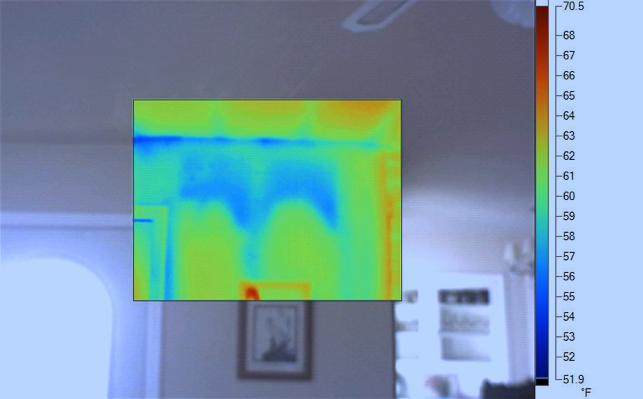Obviously the bathroom will get large amounts of water vapor every time some one showers or bathes. But generally if you have good spot ventilation, a fan that draws 80cfm or more out of the bathroom, and run it before, while, and after you shower, your moisture level should be reasonably mitigated. I suspect the problem is more than just excessive moisture in the room.
Every house has the potential for micro-climates. Micro-climates simply mean the temperature and air quality could be different in one corner of the house than another. There could even be different micro-climates within the same room. Factors like, where the heating and cooling ducts are located, how windows let sun in, and insulation voids in the walls and ceilings can create these micro-climates.
However when I hear about moisture in the top part of a wall, whether it’s a bathroom wall or bedroom wall, I immediately recommend getting an Infrared Insulation Analysis done on your home. These evaluations are relatively inexpensive and can be unbelievably telling.
In this case I suspect you would find “slipped insulation” in the wall. This would change the temperature of the wall allowing condensation to be excessive once you increased the water vapor level in the bathroom.

Slipped insulation is a common occurrence, especially in older homes. Staples will rust and disintegrate, and cavity fill will compact and settle, leaving voids where the interior wall will not hold heat.
If an analysis points to insulation slip, you’ll want to consult with a professional insulator for solutions. In the mean time you should manage the humidity in the bathroom by running your ventilation fan longer, possibly even increasing the size of the fan to help remove this excess moisture.
This type of micro climate is often most visible in the bathroom and kitchen. These locations can convert water vapor into condensation. That water vapor condensing on the walls is a natural indication of surface temperature differences.
Additionally, if you can see standing moisture on your walls, you should wipe it down with a towel. Long term moisture on any interior wall does not bode well for the wall or the humans inside who will have to breathe the mildew bloom that will inevitably occur.
For more information as to how simple ventilation can be calculated and employed in any home contact Ken at
Ken.Nelson@us.panasonic.com.
